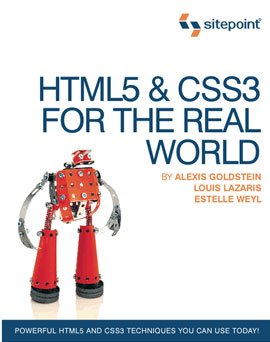
The purpose of HTML5 & CSS3 for the Real World, as title says, is to help the readers face real world problems of website building process, giving practical instruction on the new HTML5 and CSS3 resources involved in each specific need. The strong semantic nature of HTML5 specification is highly emphasized, making the reader think about all the possibilites of a truly semantic web. Also, the book offers a fairly deep historic background of the evolution of the specs.
HTML5 new tags are discussed in detail, including examples of some common use scenarios. Also, there is a small website project to follow as an example. People who is really serious about learn and understand details should try to code it from scratch. The section about CSS selectors, for example, gives a formal and in-depth coverage of the subject. It becomes easier to understand what you are doing when creating your style sheets if you know how to categorize the different selectors. Chapter 6 brings a section on CSS colors that enlightened me on basic aspects of color composition and perception.
In case you want to get up to speed quickly, I think it's ok to just skim over chapter 1, if you're not interested in HTML/CSS historic details, and chapter 5, if you don't need to work with audio, video and multimedia resources right away.
The only thing that could be a downside for some people is the fact that much of the valuable and comprehensive information you find in the book is written in prose, not structured by topics. So, if you want a mere reference book, maybe this one is not for you.
I don't now if HTML5 & CSS3 for the Real World surprised me in a positive way because I'm not primarily a front-end developer - and therefore was presented to new information that amazed me - but the fact is that I didn't expect to read such a good book on the subject.
Book page: HTML5 & CSS3 for the Real World